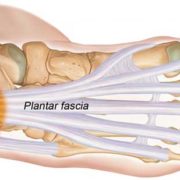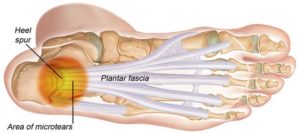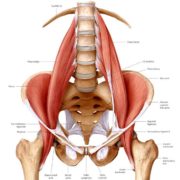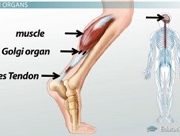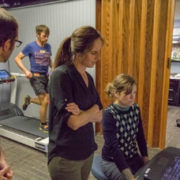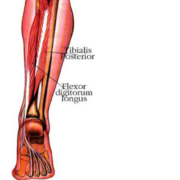By John Fiore, PT
The spring running season is underway. With Runner’s Edge Events Trail Series and Run Wild Missoula races taking place nearly every weekend, now is the time to treat your feet to reduce injury risk. The human foot is comprised of 28 bones and their associated ligaments, tendons, and muscles. This month’s article will focus on the plantar fascia which plays a large role in the Windlass Mechanism which improves intrinsic foot support. Spring is the season when plantar fascia injuries increase. Early treatment is key to avoid season-ending pain.
The plantar fascia is a thick fibrous band of connective tissue which runs from the front of the calcaneus (heel bone) to the base of the toes. It acts as a last resort to stabilize the longitudinal arch of the foot. Characterized by pain in the heel region of the arch of the foot,
plantar fasciitis is the the most common cause of heel pain requiring medical care. It is estimated that 1 in 10 people will develop plantar fasciitis in their lifetime, resulting in one million visits per year to medical visit annually. Because plantar fasciitis is often a chronic condition, understanding the causes and treatment options will lead to effective resolution.
Plantar fasciopathy is a more accurate term to describe heel and arch pain as it includes the inflammatory condition (plantar fasciitis), and degenerative condition (plantar fasciosis) of the plantar fascia. Plantar fasciitis occurs when the thick, fibrous plantar fascia becomes inflamed due to poor foot strength, repetitive arch strain, or faulty foot-ankle biomechanics. Plantar fasciosis describes the non-inflamed degenerative state of the plantar fascia due to repetitive stress.
Diagnosing plantar fasciitis involves palpating its attachment on the front of the calcaneus (heel bone). Pain is experienced during prolonged standing, running, descending stairs, and most notably upon rising and walking across the floor first thing in the morning. Additional causes of heel and plantar pain to be ruled out by your physician or physical therapist include bone stress reaction, stress fracture, localized nerve entrapment, lumbar S1 radiculopathy. Predisposing factors to plantar fasciitis include repetitive impact (distance running, jumping), rapid increase in activity level or mileage, poor intrinsic foot-ankle support, poor running biomechanics, and obesity (BMI >30).
Effective treatment of plantar fasciopathy includes four phases:
Acute Pain Phase: During the acute pain phase, pain must be reduced by avoiding running or prolonged standing, support through taping, anti-inflammatories (if inflammation is present), and reducing impact through gel heel cup and comfortable footwear. Isometric toe flexor exercises, active stretching techniques for the plantar fascia and gastroc-soleus muscle group will improve foot and ankle function.
Gradual Loading Phase: Manual physical therapy, progressive lower leg and ankle resisted exercises are added during this phase, and underlying hip, glut, and core weaknesses are addressed. Gradual plantar fascia loading exercises begin with double leg heel raises followed single leg heel raises as tolerated.
Heavy Loading Phase: Once single leg heel raises are tolerated pain-free, a barefoot modified (towel roll beneath toes) single leg calf raise progression is commenced. The Rathleff loading program (Rathleff et al 2014) continues to add resistance to single leg heel raise progressions over four weeks, building eccentric strength and tension tolerance. Running is reintroduced upon successful completion of the Rathleff program. A 2D video running analysis is vital to insure proper running biomechanics to reduce re-injury.
Successful long-term return to distance running requires regular plantar fascia release, foot intrinsic strength, and lower leg mobility and strengthening exercises. Proper footwear, adequate recovery following exercise, and gradual increases in training load will help keep plantar fasciitis and other foot issues from returning. The experts at Sapphire Physical Therapy can evaluate your running gait, detect any form or strength issues, and develop a foot injury prevention and treatment program to meet your individual needs. Call Sapphire Physical Therapy, (406) 549-5283, or learn more at www.sapphirept.com and don’t let your feet keep you from meeting your spring running goals.
1.Riddle DL, Pulisic M, Pidcoe P, Johnson RE. Risk factors for plantar fasciitis: a matched case-control study. J Bone Joint Surg Am. 2003:85-A:872-7
2 Riddle DL, Schappert SM. Volume of ambulatory care visits and patterns of care for patients diagnosed with plantar fasciitis: a national study of medical doctors. Foot Ankle Int. 2004 May. 25(5):303-10

